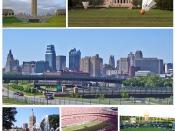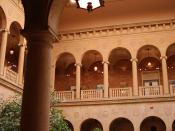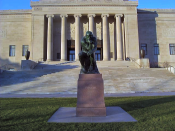The period of the 1930's brought many wonderful artistic revelations to the forefront. Cubism was booming, futurism was becoming a rage, and the United States was embarking on its own artistic niche of social realism and regionalism. One of those regions in the heartland of the Midwest was about to unleash its own artistic novelty at the intersection 45th St. and Rockhill Rd. There, lies one of Kansas City's most revered buildings. It is a building that contains not only history, but also contributes an ambiance to the cultured nature of all who pass through its doors. This building is none other than the Nelson-Atkins Museum of Art.
A majestic quality presides over the structure. It is a 232,000 square-foot art museum built especially for the people of Kansas City. Opening its doors to the public on December 11, 1933, it sits on the site of William Rockhill Nelson's estate, Oak Hall, on land given to the city by the family.
The massive structure is approximately 390 x 175 feet and rises to a height equivalent of a six-story office building. A special hard-grade Indiana limestone makes up the exterior in which the stone was originally selected for its color - a warm buff with a slight pinkish cast. Gigantic columns adorn the main entrance on the south, and behind these columns are three entrances with skillfully ornate bronze doors, the panels of which tell the story of Hiawatha. The exterior also houses twenty-three relief panels that depict the history of the Great Plains and the exploration and settlement of this area of the West. They begin with the Lewis and Clark expedition and end with the Pony Express. Charles Keck, a New York sculptor, produced this fine work.
The inside of the building is also one of awe. The...


